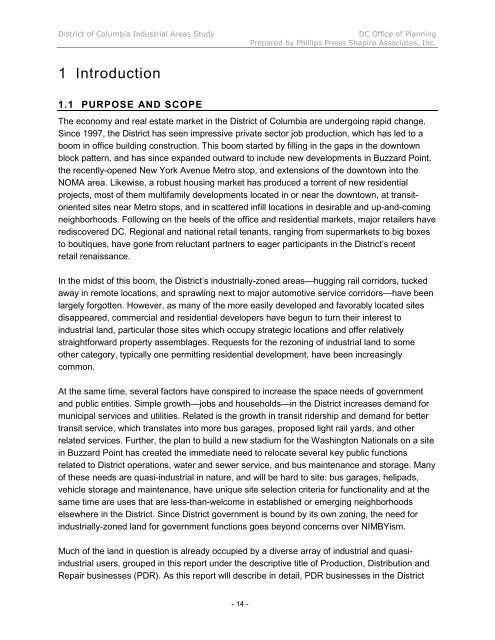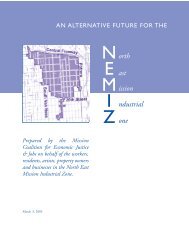INDUSTRIAL LAND IN A POST-INDUSTRIAL CITY District of ...
INDUSTRIAL LAND IN A POST-INDUSTRIAL CITY District of ...
INDUSTRIAL LAND IN A POST-INDUSTRIAL CITY District of ...
Create successful ePaper yourself
Turn your PDF publications into a flip-book with our unique Google optimized e-Paper software.
<strong>District</strong> <strong>of</strong> Columbia Industrial Areas Study DC Office <strong>of</strong> Planning<br />
Prepared by Phillips Preiss Shapiro Associates, Inc.<br />
1 Introduction<br />
1.1 PURPOSE AND SCOPE<br />
The economy and real estate market in the <strong>District</strong> <strong>of</strong> Columbia are undergoing rapid change.<br />
Since 1997, the <strong>District</strong> has seen impressive private sector job production, which has led to a<br />
boom in <strong>of</strong>fice building construction. This boom started by filling in the gaps in the downtown<br />
block pattern, and has since expanded outward to include new developments in Buzzard Point,<br />
the recently-opened New York Avenue Metro stop, and extensions <strong>of</strong> the downtown into the<br />
NOMA area. Likewise, a robust housing market has produced a torrent <strong>of</strong> new residential<br />
projects, most <strong>of</strong> them multifamily developments located in or near the downtown, at transitoriented<br />
sites near Metro stops, and in scattered infill locations in desirable and up-and-coming<br />
neighborhoods. Following on the heels <strong>of</strong> the <strong>of</strong>fice and residential markets, major retailers have<br />
rediscovered DC. Regional and national retail tenants, ranging from supermarkets to big boxes<br />
to boutiques, have gone from reluctant partners to eager participants in the <strong>District</strong>’s recent<br />
retail renaissance.<br />
In the midst <strong>of</strong> this boom, the <strong>District</strong>’s industrially-zoned areas—hugging rail corridors, tucked<br />
away in remote locations, and sprawling next to major automotive service corridors—have been<br />
largely forgotten. However, as many <strong>of</strong> the more easily developed and favorably located sites<br />
disappeared, commercial and residential developers have begun to turn their interest to<br />
industrial land, particular those sites which occupy strategic locations and <strong>of</strong>fer relatively<br />
straightforward property assemblages. Requests for the rezoning <strong>of</strong> industrial land to some<br />
other category, typically one permitting residential development, have been increasingly<br />
common.<br />
At the same time, several factors have conspired to increase the space needs <strong>of</strong> government<br />
and public entities. Simple growth—jobs and households—in the <strong>District</strong> increases demand for<br />
municipal services and utilities. Related is the growth in transit ridership and demand for better<br />
transit service, which translates into more bus garages, proposed light rail yards, and other<br />
related services. Further, the plan to build a new stadium for the Washington Nationals on a site<br />
in Buzzard Point has created the immediate need to relocate several key public functions<br />
related to <strong>District</strong> operations, water and sewer service, and bus maintenance and storage. Many<br />
<strong>of</strong> these needs are quasi-industrial in nature, and will be hard to site: bus garages, helipads,<br />
vehicle storage and maintenance, have unique site selection criteria for functionality and at the<br />
same time are uses that are less-than-welcome in established or emerging neighborhoods<br />
elsewhere in the <strong>District</strong>. Since <strong>District</strong> government is bound by its own zoning, the need for<br />
industrially-zoned land for government functions goes beyond concerns over NIMBYism.<br />
Much <strong>of</strong> the land in question is already occupied by a diverse array <strong>of</strong> industrial and quasiindustrial<br />
users, grouped in this report under the descriptive title <strong>of</strong> Production, Distribution and<br />
Repair businesses (PDR). As this report will describe in detail, PDR businesses in the <strong>District</strong><br />
- 14 -












